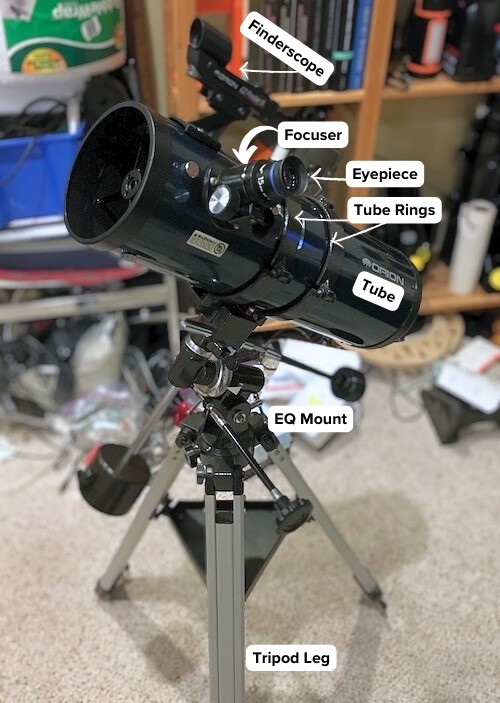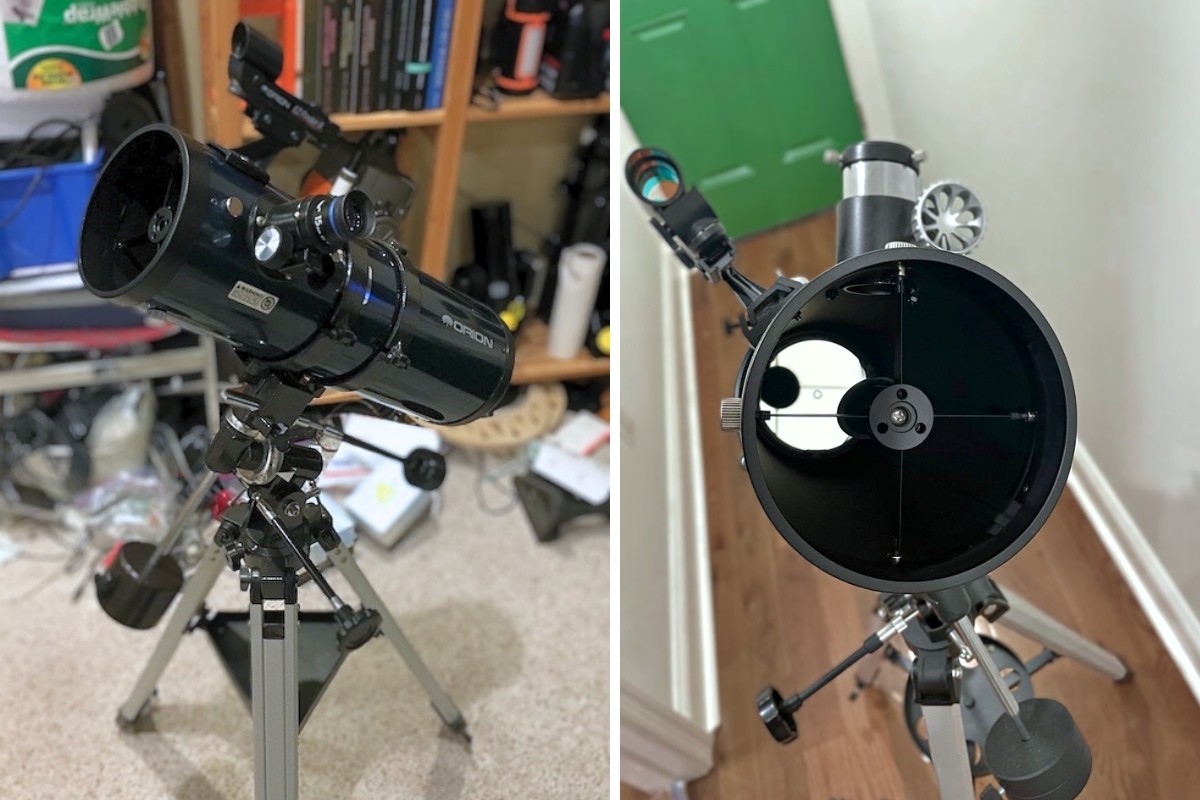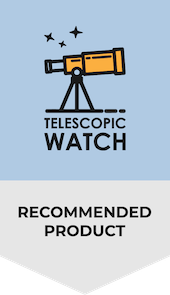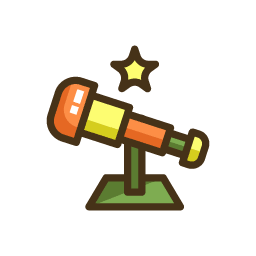The Optical Tube of Starblast 4.5 EQ

The Orion StarBlast II 4.5 EQ uses the same optical tube as Orion’s regular StarBlast 4.5 Astro but it is supplied on Orion’s EQ-1 equatorial mount instead of a tabletop Dobsonian mount and comes with much better eyepieces.
The StarBlast scopes have been around for about 20 years now, and Orion has managed to nail down the optical quality. Most StarBlasts I’ve had my hands on were pretty good optically and were capable of magnifications up to about 200x.
Buy now from AmazonThe StarBlast II 4.5 EQ is a 114mm (4.5”) f/4 Newtonian reflector with a focal length of 450mm.
At an f/4 focal ratio, I’ve observed some coma at the edge of the field of view with low-magnification eyepieces, such as the included 25mm Plossl. But even if I notice it, it doesn’t hamper the image quality too much. The scope also requires precise collimation (which it thankfully has easy-to-use, spring-loaded adjustments for, unlike some other 114mm equatorial scopes on the market).
Orion doesn’t provide a collimation tool, but you can buy/make one or simply collimate it on a star—read our guide for more information on collimation.
The Flexible Dovetail & Saddle System
The StarBlast II 4.5 optical tube attaches to its equatorial mount with a pair of tube rings that screw directly onto a Vixen-style dovetail plate.
The rings allow you to rotate the tube to adjust the position of the eyepiece as well as slide it forward/backward for balancing.
The StarBlast II’s Vixen-style dovetail plate slots into a saddle on the EQ-1 mount head. Thanks to the universal dovetail plate and saddle design, you can theoretically swap any scope you want onto the EQ-1 and move the StarBlast II to any other (preferably more stable) mount you want.
This is an improvement over the older and lower-quality EQ-1 mounts, which just have rings bolted directly to the top. StarBlast II 4.5 EQ itself used such a system until recently.
The Accessories
The Orion StarBlast II EQ comes with two eyepieces: a 25mm Sirius Plossl (18x) and a 10mm Sirius Plossl (45x). You may want to purchase an additional 6mm “goldline” eyepiece (75x) as well as a Barlow or even shorter focal length eyepiece to get the most out of your StarBlast.
The StarBlast II 4.5 is supplied with a red dot sight, which I found to be adequate for this telescope.
There’s also a moon map bundled with the scope (Orion’s MoonMap 260), which is essentially just a gimmick, and a smartphone adapter that will allow you to take shots of the moon if you so desire. But do forget serious astrophotography; that’s something for $2000 telescopes.
The Orion EQ-1 Equatorial Mount Quality
The EQ-1 mount is basically the same as the mount supplied with most of the Celestron PowerSeeker telescopes that I advise against, but the StarBlast II optical tube is small and light enough to work on the same mount quite well. And, unlike the Powerseekers, the StarBlast 4.5 II EQ has good enough optics that it’s worth talking about actually using it.
The EQ-1 is more or less a simplified version of the larger German equatorial mounts used for large telescopes and/or astrophotography. It lacks a polar scope, and the setting circles on it are so small that they’re almost entirely useless. But for visual astronomy, setting circles works just fine—don’t expect it to work well for astrophotography, however.
Setting up and using the EQ-1 is pretty easy—just level the tripod, put the mount/scope together, balance the scope on both axes, and roughly line up the mount’s polar axis with Polaris. Coarse motion is achieved by simply pushing/pulling the scope around the sky, while fine adjustments are made with the two included flexible slow-motion cables.
If I need to rotate the tube to put the finder/eyepiece in a more convenient position, I’d just slightly loosen the tube and rotate it in the tube rings (while being careful not to slide it forward/backward and ruin the balance).
What can you see?
The StarBlast II’s high-quality optics will show you Mercury and Venus’ phases, along with the dark albedo patches and ice caps on Mars. You can also see Jupiter’s cloud belts, the Great Red Spot and its 4 large moons. Saturn’s rings, the Cassini Division, the planet’s cloud belts, and about half a dozen of its moons are visible. Uranus and Neptune can be spotted as small turquoise and azure dots, respectively, though locating them can be a bit tricky. Their moons are unfortunately too dim for the StarBlast to reveal.
Outside the solar system, the StarBlast excels at revealing large star clusters and nebulae. The Veil Nebula is easily visible with a good UHC or OIII filter. Orion, the Lagoon, and the Swan look excellent with even mediocre suburban skies. The scope can also pick up some of the brighter/larger galaxies, such as M31, M51, the Leo Triplet, M81/82, and perhaps M101 and M33 with dark enough skies. You’ll even be able to spot planetary nebulae such as the Ring—a small donut-shaped fuzz that you might mistake for an out-of-focus star—the Dumbbell, the gorgeous blue NGC 2392, the Cat’s Eye, and the famous Blinking Planetary Nebula.
Alternative Recommendations
For similar prices to the Orion StarBlast II 4.5 EQ, there isn’t a better deal to have if you are adamant on a tripod-mounted scope. But if you can compromise on that and have a Dobsonian mount instead, there are a number of other scopes you might want to consider, including the following:
- The Sky-Watcher Heritage 150P is considerably quicker and easier to set up than the StarBlast II 4.5 EQ as well as featuring a larger diameter primary mirror for more light gathering and resolving ability, along with an easy-to-use and rock-steady tabletop Dobsonian mount.
- The Sky-Watcher Heritage 130P offers slightly more light collecting area and resolving power than the StarBlast II 4.5 EQ along with an ultra-compact collapsible tube and simple tabletop Dobsonian mount.
- The Orion StarBlast 4.5 Astro/Zhumell Z114 use the same optics and similar accessories to the StarBlast II 4.5 EQ but with a steadier, simpler, and more compact tabletop Dobsonian mount.
Aftermarket Accessory Recommendations
The most useful accessory I’d recommend for the StarBlast II is a 6mm “goldline” eyepiece which will provide 75x with the scope. This is a good magnification for viewing the Moon, planets, and double stars. A quality 2x Barlow will provide 36x and 90x with the stock eyepieces and 150x with the 6mm goldline, providing an even wider and more useful range of magnification.
Additionally, the EQ-1 is compatible with a motor drive. Celestron’s single-axis motor drive is designed for simple single-axis tracking. If you want to get fancy, the Orion EQ-1M unit (which costs a substantial portion of the price of the entire telescope) allows you to slew the telescope in right ascension back and forth with the push of a button, and adjust the rate for sidereal or lunar tracking speeds. The drive is battery-powered and will offer at least semi-accurate tracking.




Compare to skyhawk 1145p? Will skyhawk do better on planetary due to it longer focal lenght? Should i consider buying 3x barlow to improve planetary viewing? Sorry no more question hehe
3x Barlows tend to be of poor quality. A dedicated short focal length eyepiece is best.
Is the tripod stable enough to avoid “shaking” while on high magnifications?
For the most part.
Currently have Celestron 70DX toy travel scope. Have read many of your reviews, have budget under $250 and this seems to be good telescope to improve my observable universe. Will this be good upgrade or will I be disappointed by still seeing Jupiter as white dot with 4 coplanar dots. Meade Polaris 130 EQ seems comparable but can’t find it anywhere to buy. Do you recommend a better telescope for my budget?
I would get the StarBlast, a Zhumell Z130, or save up for a 6″ Dob.
Thanks.
We’re looking into getting started and looking for some advice on which telescope would be best for us. We are mainly interested in viewing planets and don’t really mind to spend a little more on eyepieces if it will better the experience. Currently looking at this one and the meade polaris 127mm and 130mm models. Thanks
The Polaris 127 is a Bird-Jones like the Powerseeker 127EQ. The 130 is not bad. I personally would go for the StarBlast though, or get a 6″ Dob which will beat either.
Ok thank you very
Looking for a sub $200 telescope for my 9-year-old who wants to view the planets, stars and some deep space objects. We’re both beginners and it sounds like this may be the one to get as our first telescope. Any other recommendations for a kid to use, or should we go with this one?
The tabletop Starblast, Sky-Watcher Heritage 130P or one of the Zhumell scopes might be a better choice since they’re easier to use.
I’m aware that the table top is not suitable for mounting a dslr, but what about this mount?
I want to use my Nikons for entry level astrophotography.
Thanks
How would this compare to meade polaris 130, will the 16mm aperture difference really make a difference in what I will see?
The StarBlast is better optically and has better accessories, which bridges the gap somewhat
Hello sir
I would like to ask if this scope is better or worse than the celestron powerseeker 114 eq, i am on a tight budget and want something under 300 dollars, and still get decent views of the planets and other celestial bodies
thanks
The StarBlast is a LOT better than the PowerSeeker 114EQ.
Hi
Now, when Orion Observer 134mm Reflector costs only $20 more, isn’t it better?
Sadly no. The new Orion Observer scopes have poor optical/mechanical quality and accessories.